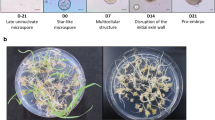Abstract
In order to better understand androgenic albinism in barley, we compared plastid differentiation during anther culture in two cultivars, an albino (spring cultivar Cork) and a non-albino (winter cultivar Igri) producing cultivar. The ultrastructure of plastids and the relative amount of DNA containing plastids were followed in both cultivars during the androgenic process and correlated with the proportion of regenerated chlorophyllous plantlets.
For androgenesis, anthers were collected at the uninucleate stage, during mid- or late-microspore vacuolation. At this stage DNA was detected in 15.3 ± 2. 7% of microspore plastid sections in the winter cultivar Igri, compared to 1.7 ± 0.5% in the spring cultivar Cork. In the winter cultivar Igri, starch was broken down after anther pretreatment but plastids divided rapidly during anther culture and thylakoids developed in the stroma. Prior to regeneration, plastids contained 2.0 ± 0.2 thylakoids per plastid and starch represented 26.1 ± 3.3% of the plastid volume. In the spring cultivar Cork, plastids followed a different developmental pathway. After anther pretreatment, microspore plastids differentiated exclusively into amyloplasts, accumulating starch and losing their thylakoids as well as their capacity to divide. This developmental pattern became progressively more marked, so that by the end of anther culture plastids contained 0.5 ± 0.4 thylakoids per plastid and starch represented up to 90.3 ± 4.3% of plastid volume. Following androgenesis, the response was similar in both cultivars except that the winter cultivar Igri provided 87.8% of chlorophyllous plantlets compared to 99.7% albino plantlets in the cultivar Cork.
The results presented here suggest that the exclusive regeneration of albino plantlets in the spring cultivar Cork may be due to degradation of microspore plastid DNA during early pollen development, preventing the plastids from differentiating into chloroplasts under culture conditions.
Similar content being viewed by others
Author information
Authors and Affiliations
Additional information
Received: 13 March 2000 / Revision accepted: 6 June 2000
Rights and permissions
About this article
Cite this article
Caredda, S., Doncoeur, C., Devaux, P. et al. Plastid differentiation during androgenesis in albino and non-albino producing cultivars of barley (Hordeum vulgare L.). Sex Plant Reprod 13, 95–104 (2000). https://doi.org/10.1007/s004970000043
Issue Date:
DOI: https://doi.org/10.1007/s004970000043




